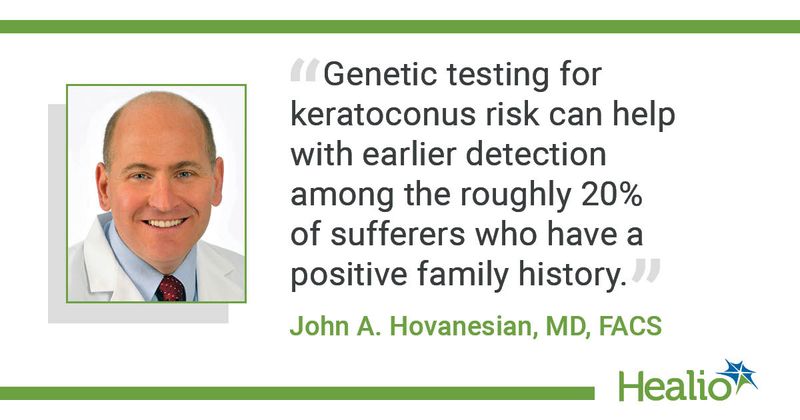Where keratoconus treatment should be
Despite all our advances, keratoconus remains a major cause of visual disability, even in the developed world.
The advanced form of this disease accounts for about one-third of penetrating and anterior lamellar corneal transplant procedures each year, according to the Eye Bank Association of America. Some studies have shown that, in certain ethnic populations, keratoconus is present in up to 20% of patients presenting with interest in refractive surgery. The real incidence in the general U.S. population may be as high as 1% to 2%. Despite our efforts, this disease is a big problem, demanding a more effective approach than we are currently taking.

Many believe an effective approach begins with earlier detection. As the cover story in this issue of Healio/Ocular Surgery News discusses, keratoconus is never present at birth. Rather, it slowly progresses until middle age. Its earliest manifestations can come in the first decade of life, a time when school vision screening is not entirely reliable, and subtle early findings can escape detection.
Probably our strongest efforts should be concentrated in this very young, presymptomatic population before progression leads to irreversible corneal irregularity and thinning that results first in a need for spectacles, then as the disease progresses soft contact lenses, then rigid contacts or scleral lenses, and then lamellar or penetrating keratoplasty.
Genetic testing for keratoconus risk can help with earlier detection among the roughly 20% of sufferers who have a positive family history. AvaGen (Avellino) now offers a commercially available cheek swab test that I would absolutely use in my children if I had a family member with this disease. But because the majority of patients with keratoconus have no family history to trigger a genetic test, we need other inexpensive and widely available predictors to use in children.
Currently, most children undergo a school vision screening program about every 3 years to identify impending amblyopia — a condition that occurs in about 2% of U.S. children, according to a 2009 study. Keratoconus has about the same incidence when rigorous criteria are used for detection. Should we not require corneal topography for all children in their early teen years?
Once keratoconus is found, our existing treatments are good but also need to be better. One major improvement would be eliminating the removal of epithelium — a practice that dates back 25 years to the first experiments with cross-linking in Europe. Despite ample evidence that epithelium-on cross-linking is equally effective and reduces risks for infection and scarring, no FDA-approved combination of riboflavin plus UV light exists for this cornea-sparing approach.
Many U.S. surgeons are already performing epithelium-on treatments using UV devices imported from Europe or designed for treating dermatologic disease. They use riboflavin from compounding pharmacies, made in higher concentrations for better absorption. They roughen, if not completely remove, the corneal epithelium to further facilitate drug absorption through a mostly intact cornea. Indeed, this approach works, is well justified and is better for patients, but isn’t it a shame that it is still not FDA approved?
A leapfrogging innovation would be cross-linking without UV light. Decorin and other compounds have been shown to trigger UV-free collagen cross-linking that could one day replace this procedure with just a drug. We need to invest in more of these solutions to create an ecosystem of competition and drive down the cost of treatment.
Cost and coverage of treatment are the final current barriers we must overcome. Although progress has been made in fair reimbursement from some insurance carriers, the majority of patients must pay out of pocket for cross-linking. With an on-label cost of $3,500 per eye for riboflavin, how many young parents can afford treatment for their child?
Evolving detection methods are showing us the latent magnitude of our problem with keratoconus, and our scientific community is not as well prepared as it should be. We have tools and techniques that work but more barriers to their success than our young population deserves. In the future, nobody with this disease should progress to the point of needing a corneal transplant.
References:
- Al-Amri AM. J Ophthalmol. 2018;doi:10.1155/2018/5983530.
- Friedman DS, et al. Ophthalmology. 2009;doi:10.1016/j.ophtha.2009.04.034.
- Santodomingo-Rubido J, et al. Cont Lens Anterior Eye. 2022;doi:10.1016/j.clae.2021.101559.
Collapse
